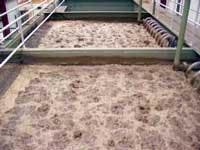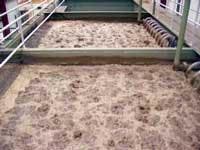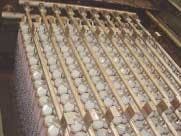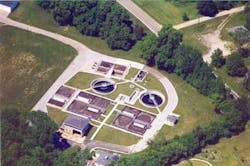The MemJet-C technology combines two USFilter processes — the MemJet™ membrane bioreactor (MBR) technology from USFilter Memcor Products and the Cannibal™ solids reduction process from USFilter Envirex Products — to produce reuse-quality water that is low in nitrogen and phosphorus.
The membrane separation process eliminates the need for a clarifier or polishing filter. Additionally, the positive liquid-solids separation microfiltration process retains the biomass in the reactors, allowing the reactor to be operated at mixed liquor suspended solids (MLSS) levels of up to 16,000 mg/L.
Operating at high MLSS levels can increase solids retention time, reducing sludge yield and improving reactor efficiency for nitrification and denitrification. High MLSS levels also mean that plants can operate at shorter hydraulic retention times, allowing smaller reactor basins than conventional treatment, reducing plant space requirements. Often, this allows an existing conventional plant to be retrofitted by replacing its clarifier with a membrane system, producing higher wastewater volumes in the same plant space in addition to higher water qualities.
Solids Reduction Process
The mixed liquor solids that are generated in the main treatment process are separated from the effluent using the membranes and are sent to the Cannibal system. The Cannibal process eliminates routine biological solids wasting through the use of a patented digestion process that interchanges the biomass between aerobic and facultative conditions. By alternating the mixed liquor through the environments of the aerobic treatment process and a non-aerobic sidestream bioreactor, a steady-state balance between biological selection and destruction is developed, and results in no net biological solids produced.
Trash, grit and other inert materials that would otherwise build up in the system are removed from the process through the use of a patented solids separation module on the return sludge line. An ultra-fine screen separates the trash and grit from the mixed liquor biomass, while a series of hydrocyclones removes the very fine inert material. Removal of this inert material, which can be up to 15 to 20 percent of the mixed liquor solids, results in a maximum overall solids reduction. Additional ultra-fine inerts are removed by purging a small amount of biological solids over the course of a year.
Benefits
Combining the two processes enhances the MBR technology's performance and significantly reduces the solids produced by the treatment process. The removal of trash, grit and inerts from the return sludge frees up room in the treatment process for more biomass growth, and removal of these inert materials greatly improves the operation of the membranes by increasing the average flux rate, increasing membrane life, and reducing maintenance requirements.
Other benefits of the combined process include:
• small footprint for treatment of both the liquid and solids streams;
• compliance with strict environmental regulations;
• production of effluent suitable for reuse applications;
• less operator attention and maintenance;
• reduction of biosolids production;
• elimination of sludge thickening and dewatering equipment, sludge storage and holding tanks;
• reduction of operational costs associated with sludge holding, digestion and dewatering facilities; and
• reduction of sludge hauling and final sludge disposal costs.






